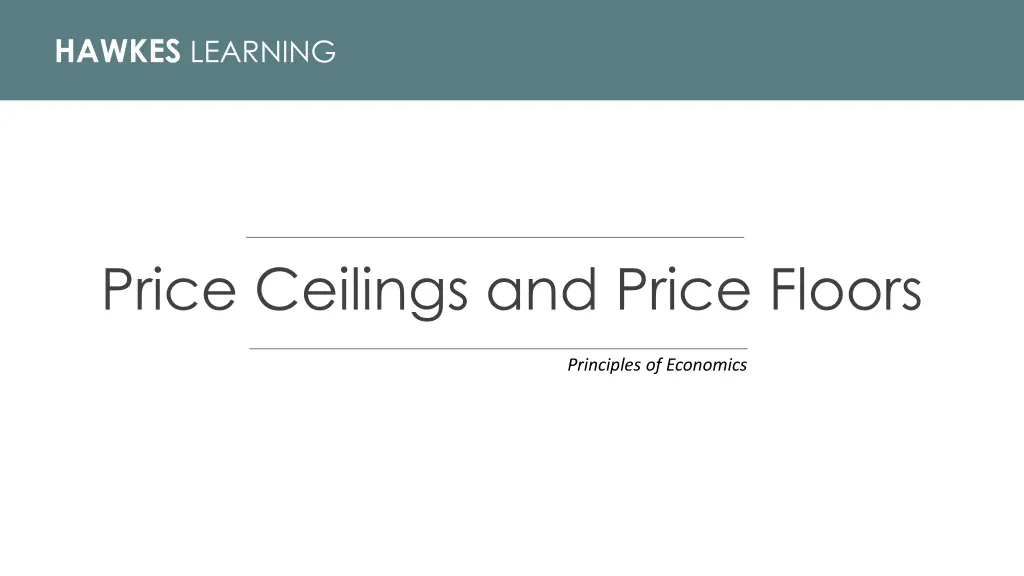
Understanding Price Ceilings and Price Floors in Economics
Explore the concepts of price ceilings and price floors in economics, including the reasons for implementing them, how they impact market outcomes, and real-world examples such as the minimum wage. Learn how these price controls influence supply, demand, and equilibrium in a market economy.
Download Presentation

Please find below an Image/Link to download the presentation.
The content on the website is provided AS IS for your information and personal use only. It may not be sold, licensed, or shared on other websites without obtaining consent from the author. If you encounter any issues during the download, it is possible that the publisher has removed the file from their server.
You are allowed to download the files provided on this website for personal or commercial use, subject to the condition that they are used lawfully. All files are the property of their respective owners.
The content on the website is provided AS IS for your information and personal use only. It may not be sold, licensed, or shared on other websites without obtaining consent from the author.
E N D
Presentation Transcript
HAWKES LEARNING Price Ceilings and Price Floors Principles of Economics
Why Set Price Ceilings or Price Floors? It is often assumed that markets are free; that is, they operate with no government intervention, but this is not always the case. Controversy often surrounds the prices and quantities established by demand and supply, especially for products considered necessities. Discontent over prices often pressures politicians, who may then pass legislation to prevent a price from becoming "too high" or "too low." Governments can pass laws affecting market outcomes, but no law can negate economic principles.
Price Controls The government will set price controls in the form of price ceilings and price floors, which can be either binding or nonbinding.
Price Ceiling A price ceiling is a legal maximum price that one pays for some good or service. A government imposes price ceilings in order to keep the price of some necessary good or service affordable. For example, the government could set a price ceiling on rent to prevent housing from becoming too expensive.
Price Ceiling A price ceiling is binding if set below the equilibrium price, as it forces a lower price. A binding price ceiling initially creates a shortage, as quantity demanded will exceed quantity supplied. A price ceiling above the equilibrium price will not be binding, as the equilibrium point has not yet reached the ceiling .
Price Floor A price floor is the lowest price that one can legally pay for some good or service. Price floors are sometimes called "price supports" because they support a price by preventing it from falling below a certain level. A price floor helps producers because it holds up a price the government feels is too low. Perhaps the best-known example of a price floor is the minimum wage, which guarantees a basic standard of living for workers.
Price Floor A price floor is binding if set above the equilibrium price, as it forces a higher price. A binding price floor initially creates a surplus, as quantity supplied will exceed quantity demanded. A price floor below the equilibrium price will not be binding, as the equilibrium point has not yet surpassed the floor .
Real-World Discussion Opponents of the minimum wage often argue that since the minimum wage is a price floor, it creates a surplus of workers, which is unemployment. Others who favor the minimum wage argue that the minimum wage does not contribute to unemployment. Use demand and/or supply curves to explain how the minimum wage may not contribute to unemployment.
Unintended Consequences The first rule of economics is you do not get something for nothing everything has an opportunity cost. If a price ceiling forces a lower price, then the quality may diminish, such as lower quality housing following rent control. In the case of agriculture, farmers can benefit from a price floor, but taxpayers and consumers of food will pay the costs. Price controls usually cause a shortage/surplus, meaning the market is not in its natural equilibrium.
Summary Price ceilings prevent a price from rising above a certain level. When a price ceiling is set below the equilibrium price, quantity demanded will exceed quantity supplied, and excess demand or shortages will result. Price floors prevent a price from falling below a certain level. When a price floor is set above the equilibrium price, quantity supplied will exceed quantity demanded, and excess supply or surpluses will result. Price floors and price ceilings often lead to unintended consequences.
